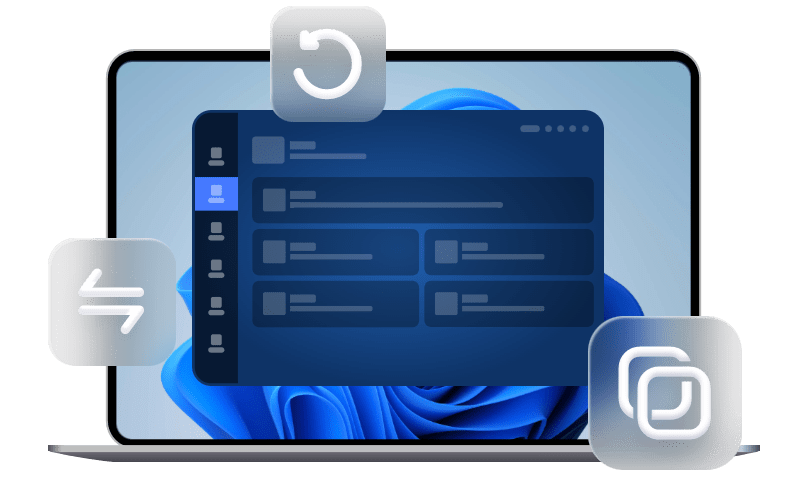How to Backup Work Emails With Gmail & Outlook
You can learn how to backup work emails in Outlook and Gmail, and learn a professional email backup software for easy backup of email account data.
Why Do You Need to Backup Work Emails?
Backing up work emails is crucial. There are several reasons why it is important to back up work emails:
★ Data Loss Prevention: Work emails often contain critical information such as important communications, attachments, project details, client interactions, and more. By regularly backing up work emails, you can protect against potential data loss caused by hardware failures, software glitches, accidental deletion, or other unforeseen events.
★ Legal and Compliance Requirements: Many industries have specific regulations regarding data retention and record-keeping. Backing up work emails helps ensure compliance with these regulations, providing a reliable and easily accessible archive of important communications that may be required for legal or regulatory purposes.
★ Disaster Recovery: In the event of a disaster, such as a fire, flood, or system failure, having backups of work emails ensures business continuity. It allows you to quickly restore critical emails and resume operations without significant data loss or disruption.
After knowing these reasons, you may ask: “How do I back up all my work emails?”, no need to worry! This article will introduce you how to backup work emails in Gmail and Outlook respectively. Finally, we will recommend you a universal email backup software to make sure all your work emails are backed up on one interface.
How to Backup Work Emails with Different Email Clients
In this section, we will introduce you to how to backup work emails in Gmail and Outlook respectively, let's take a look!
1. Backup Work Emails with Gmail
In this part, we will tell you how to backup emails on Gmail. To enable local storage of your Gmail messages through any email client, you can set up POP access. By default, this protocol deletes the original messages from the webmail inbox after they are downloaded. However, Gmail offers flexibility in choosing whether to delete, archive, keep, or mark them as read.
Follow these steps to enable POP access in Gmail:
Step 1. Sign in to your Gmail account and click on your profile icon to access Google Account settings.
Step 2. Navigate to the Security section and scroll down to find Less secure app access. Click on it to allow access for less secure apps. This step ensures that Gmail doesn't reject a server connection established from a remote client.
Step 3. Configure the POP settings by accessing the Settings page.
Step 4. Go to the Forwarding and POP/IMAP tab. In the POP download section, switch to Enable POP for all mail. Additionally, the second option determines the action to be performed on the original messages after a copy is saved. For this example, we will choose to keep the original messages.
By following these steps, you will successfully enable POP access in Gmail and have control over managing your messages locally.
Tip: To access the Gmail server settings, click on the Configuration Instructions link located below the Configure your email client option. Scroll down the page to locate the relevant information.
2. Backup Work Emails with Outlook
In this section, we will describe how to backup emails in Outlook. If you utilize email for work, it is highly probable that you are utilizing either an Exchange or IMAP account. These types of accounts offer automatic email archiving on Exchange and IMAP servers, enabling convenient access to your messages from any location.
To create local backups of your message folders, in addition to retaining them on the server, there are a couple of approaches you can take. Firstly, you can employ the AutoArchive feature to automatically relocate or delete older items. Alternatively, you can export the items to a .pst file, which can be stored for future utilization. This .pst file can be easily restored as needed by importing it into your email client. Follow these steps to learn how to save all emails from Outlook now.
Step 1. Navigate to the File tab and choose Open & Export followed by Import/Export. In a new window, select the option to Export to a file and proceed by clicking the Next button.
Step 2. Choose the option for Outlook Data File (.pst) and click on Next.
Step 3. Choose the desired mail folder that you wish to back up and click Next. Select a location and provide a name for your backup file, and click on Finish.
Step 4. If you desire heightened security for your files, you can establish a password by entering and confirming it. Finally, click OK to proceed.
Backup All Work Emails Easily via Professional Email Software
After showing you how to back up work emails in Gmail and Outlook, I think you may find it a bit cumbersome and complicated. So in this part, I would like to recommend you a professional automatic email backup software - AOMEI Backupper Pro. The email backup function of this software can help you back up all your work emails easily. And you don't have to think about how to backup work emails anymore, and we will provide you with detailed steps now.
Here are some of the noteworthy features of this backup software:
☁ Platform Support: Enjoy the versatility of this software as it can back up emails from various platforms, including Gmail, Outlook Mail, Yahoo! Mail, iCloud Mail, Zoho Mail, Hush Mail, GMX Mail, Hot Mail, and many others.
☁ Comprehensive Email Data Backup: This software effortlessly backs up all your email data, including emails, contacts, notes, calendars, and tasks, ensuring a comprehensive backup solution.
☁ Automated and Efficient: Take advantage of the Schedule Backup feature, which allows you to automate backups with options like daily, weekly, monthly, event triggers, and USB plug in. The software also offers incremental and differential backup methods to optimize disk space and improve efficiency.
☁ Windows Compatibility: The professional version of this software seamlessly runs on a variety of Windows operating systems, including Windows 11/10/8.1/8/7/XP/Vista.
☁ Flexible Backup Destinations: Choose from a range of backup destinations to suit your preferences. Options include your computer, external hard drive, USB flash drive, cloud storage, NAS device, and more, allowing you to store your email backups in a way that suits your needs.
In addition to these features, there are many more interesting functionalities awaiting your exploration. In the next section, we will provide a graphical demonstration of how to backup emails. First download this program, install and run it.
Tip: If you are a server user, kindly download AOMEI Backupper Server version.
Step 1. Navigate to the left tab page and select Backup. Next, select Email Backup from the list of available options.
Step 2. Click on the Add Email Data button.
Step 3. Click on Add Mailbox, which will trigger a pop-up window. Here, you'll need to provide important details such as your email account and authorization code, so ensure that you fill in all the necessary information accurately.
Step 4. Once you have selected the desired email source for backup, proceed to select a destination path where you wish to store the backup.
Step 5. Click on the Start Backup button to back up your work emails.
Summary
This article takes Gmail and Outlook as examples respectively to tells you how to backup work emails. But both methods require some computer knowledge, so if you want to back up your work email or other data easily, we suggest you to use a professional email backup software - AOMEI Backupper. In addition to the powerful features previously described, it also has a restore feature that can perform Windows 11 system restore from boot. Try it out now!

